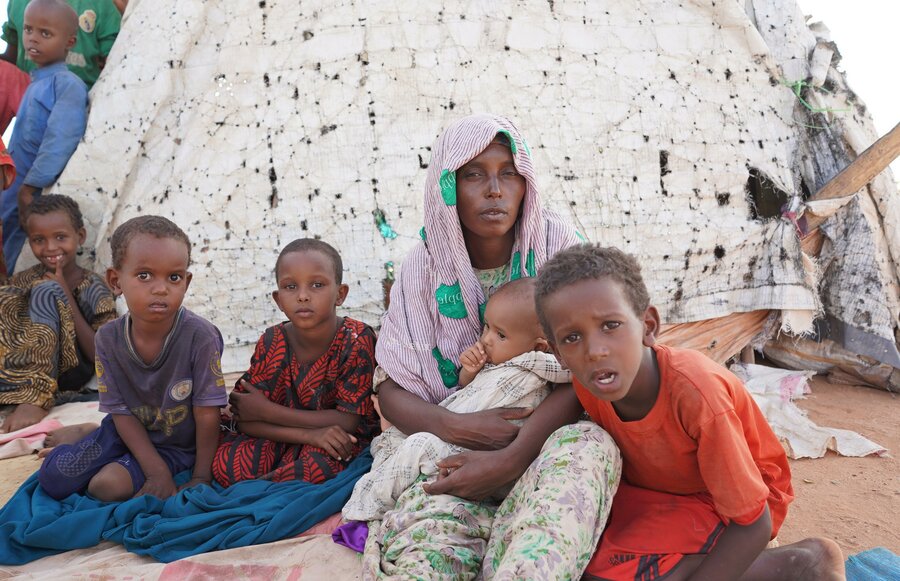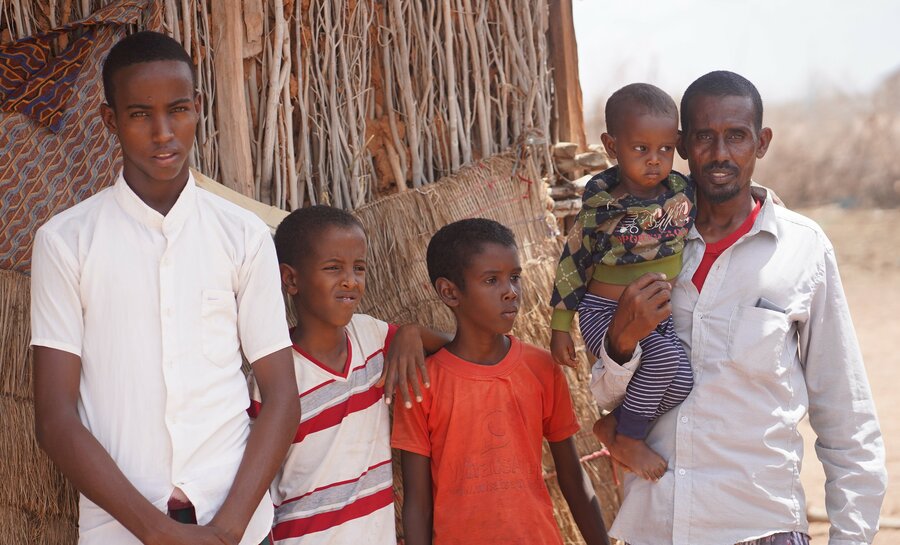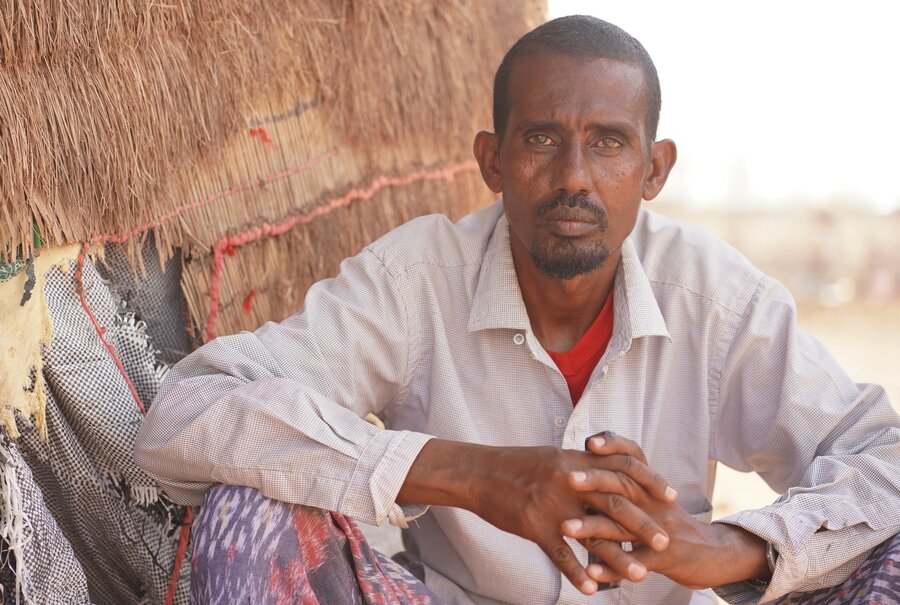Climate change wreaks havoc on livelihoods in Ethiopia’s Somali region

As day breaks across Ethiopia’s Somali region, Sadiq Gedi heads out across the dried-up riverbed on a quest for an oasis in the desert. Sadiq is accompanied by four of his children, who he recently had to pull out of school because he could no longer afford the fees. As he carries a yellow jerrycan in each hand, the children chatter and kick empty plastic bottles along the way.
After five kilometres or so, they join their neighbours to shelter under a tree from the heat of the rising sun and wait for the local-authority water truck to arrive. As soon as the faint roar of an engine can be heard in the distance, there’s a rapturous round of applause. The five 20-litre jerrycans will be the 42-year-old and his family’s only source of water for the next week, or until the truck comes again.

For these residents of Dollo Bay, life can be a constant struggle even at the best of times. The income they earn from raising livestock is barely enough to feed Sadiq’s 12 children, and drought conditions are pushing them to the brink.
“It’s been so long since we’ve had enough water for farming, I can’t remember,” says Sadiq. “But now the river has entirely dried up, we are lacking the water to drink and eat. We only have enough to cook once a day.”
Sadiq says they are “luckier than some” as they receive wheat, split peas, and cooking oil from the World Food Programme, as well as water from the local water authority.
He adds: “I’ve seen others suffering because of hunger. People are very thin and too weak to walk.”
In Ethiopia, there are an estimated 12.9 million people experiencing high levels of food insecurity, according to the latest IPC analysis.
Two million of the most food-insecure Ethiopians live in the Somali region, where the majority of families depend on agriculture and livestock, living harvest-to-harvest.
Four consecutive years of drought, followed by the poor hagaya-deyr (the short rainy season from October to December which communities were holding out for), have led to significant production losses in southern pastoral areas during the belg (February to April agricultural season).
The drought has also affected the health, quality and prices of livestock. Coupled with high staple food prices, this has led to widespread food insecurity.
In a cruel twist of fate, at the start of May, the Somali region’s drought turned into flash floods overnight. The rain fell suddenly and forcefully. Some parts of the region saw as much rain in a day as they normally would receive in a whole month.

Weak and malnourished, livestock were washed away, crops were obliterated, and pastoralists saw their entire livelihoods disappear before their eyes. In Shabelle, one of nine zones in Ethiopia’s Somali region, the river has overflowed for over a month — displacing around 15,000 families and wiping out over 3,000 cattle, goats and sheep.
According to Mohammed Khalif Hujal, the local administrator of Dollo Ado woreda (district), the changing climate is forcing families like Sadiq’s into chronic vulnerability with nowhere left to turn.
“This area is on the frontline of climate change and suffers from a dichotomy of natural hazards, drought followed by floods, both of which are causing disasters and disrupting the livelihoods of community members, who are largely pastoralists,” says Hujal. “At the moment, it should have been harvest time, but we are struggling with drought followed by intense floods instead.”
Sadiq has noticed how the changing climate affects his livestock. “In the past, when the season used to be good, our cows and goats were grazing and filling their stomachs,” he says. “They provided, milk, meat, they ploughed the fields and we sold them. Now though, they are sick, malnourished and I am feeding them by hand out of my own poor food stocks.”
Severe drought and flooding is also forcing thousands of families out of their homes and into displacement camps. A recent assessment conducted by Agency for Technical Cooperation and Development (ACTED) found that 85 percent of displaced people in the Somali region reported the main reason for their displacement as “loss of livelihood due to drought.”
Keira Abdillé, a 40-year-old mother of three, used to earn a living as a pastoralist some 60 kilometres from the IDP (internally displace people) camp in Dollo Ado where she currently resides. “We had 100 goats and sheep, but all of them died and we had to come here to save our lives,” says Keira. For now, she and her family are dependent on shelter from the Government and relief food from WFP.
The situation is only set to worsen, especially in the Somali region, hampered by climate shock after shock. According to a recent climate risk profile conducted by USAID, since the 1960s, Ethiopia has experienced more intense storms, more frequent and severe droughts, and belg season rains that are more unpredictable in timing. Climate change may decrease national GDP by 8-10 percent by 2050 — a hefty contraction that could hamper growth.
But all is not lost. If adaptation action for agriculture and livestock rearing is taken now, it could cut losses related to climate shock in half.
Beyond delivering relief food, WFP is helping communities protect their precious assets and ability to cope in the face of the changing climate. The Satellite Index Insurance for Pastoralists in Ethiopia (SIIPE) project — on which WFP collaborates with the Government and private sector partners — provides around 30,000 pastoral households in the Somali region with insurance products that protect their herds when extreme drought wipes out their pasture.
To date, the project has led to a payout of US$430,000 for 4,673 pastoralists. It also helps vulnerable smallholder farmers with fuel and seeds to help them produce crops and protect their core assets.
WFP needs an additional US$97 million to respond with urgently needed food assistance for 2.4 million people in the Somali region during the next six months. Without it, the future for Sadiq, Keira, and thousands of the most vulnerable families will be even bleaker.
Learn more about WFP's work in Ethiopia
